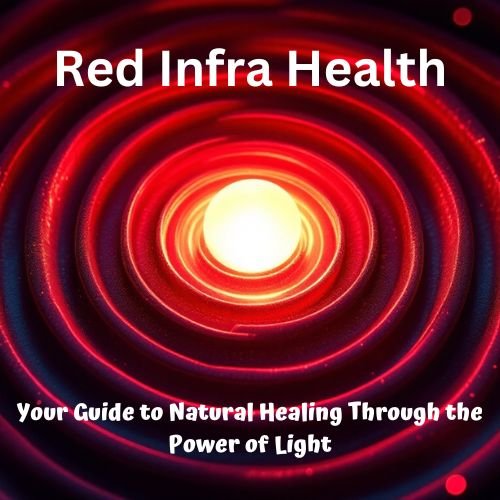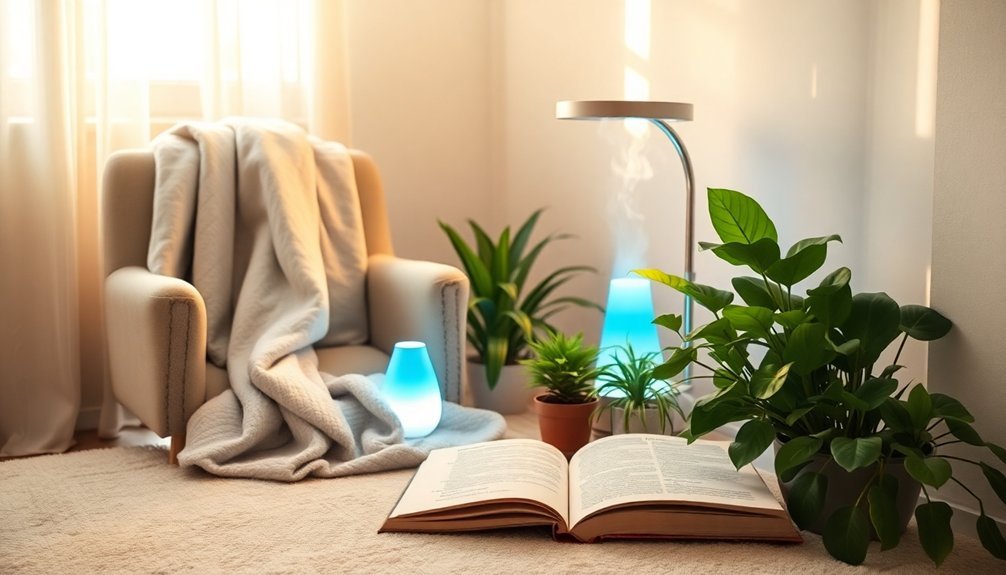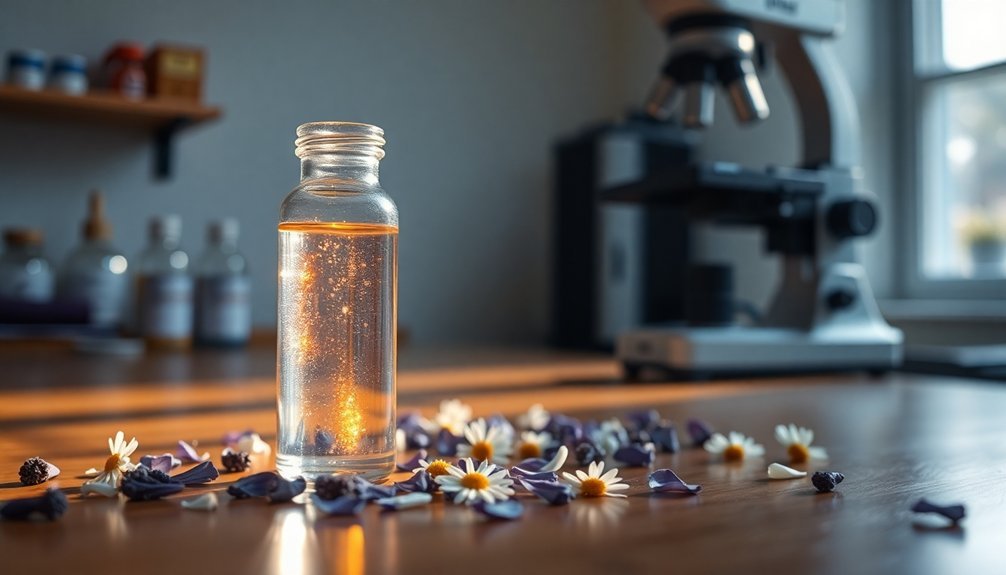Light therapy offers an effective, science-backed solution for winter depression by mimicking natural sunlight's mood-lifting benefits. You'll need a 10,000-lux light box that you can use for 20-30 minutes each morning, positioned 16-24 inches from your face. The targeted wavelengths help regulate your body's circadian rhythm, boost serotonin levels, and suppress excess melatonin production – all key factors in managing seasonal depression symptoms. Combine this therapy with vitamin D supplements, regular exercise, and proper sleep habits for ideal results. Understanding how targeted wavelengths work can transform your approach to conquering winter blues.
Understanding Seasonal Light Deficiency

Darkness during winter months can profoundly affect your body's natural rhythms and mental well-being. When you're exposed to less sunlight, your brain's production of key neurotransmitters becomes disrupted, particularly serotonin and melatonin. This chemical imbalance can trigger a cascade of biological changes that affect your mood, sleep patterns, and overall energy levels. Many people experience carbohydrate cravings and overeating during winter months as their bodies attempt to regulate mood through food intake.
Your geographical location plays a vital role in how severely you'll experience these effects. If you live far from the equator, you're more susceptible to Seasonal Affective Disorder (SAD) due to the extreme variations in daylight hours.
Your body's internal clock relies on consistent light exposure to maintain proper function, and when this natural rhythm is disturbed, you might notice changes in your appetite, concentration, and social behavior.
Women and younger adults face a higher risk of developing SAD, especially if there's a family history of depression. Your brain's response to light directly influences your mood regulation center, which explains why some people need more light exposure than others to maintain emotional balance.
Understanding these biological mechanisms helps explain why specific wavelengths of light, whether natural or artificial, can effectively combat seasonal depression symptoms.
Light Therapy Science Explained
Light therapy stands as a scientifically proven method to combat seasonal depression through controlled exposure to specific wavelengths of light. When you're exposed to therapeutic light, particularly in the morning, it triggers essential biological responses in your body. The light suppresses melatonin production while boosting serotonin levels, helping to regulate your circadian rhythm and improve your mood.
You'll find different types of light therapy available, each serving specific purposes. Bright light therapy uses 10,000 lux intensity to simulate natural sunlight, while red light therapy employs specific wavelengths to reduce inflammation and promote cellular health. Studies show that bright light and dawn simulation have comparable success rates in treating seasonal affective disorder.
Dawn simulation gradually increases light exposure, mimicking natural sunrise to help reset your body clock.
The effectiveness of light therapy isn't just anecdotal – clinical research, including NASA studies and the ELATED-2 trial, has demonstrated its antidepressant properties. You'll experience benefits that can last for at least a month after treatment, and since modern devices filter out harmful UV rays, you won't need to worry about skin damage.
For winter depression specifically, morning light therapy proves particularly effective by compensating for reduced natural sunlight exposure during darker months.
Choosing Your Light Treatment Device

When you're selecting a light therapy device, you'll want to focus on models offering 10,000 lux intensity and adjustable brightness settings to guarantee effective treatment in shorter sessions.
Your device should include features like customizable color temperature settings and easy-to-use controls that let you adapt the therapy to your specific needs. Treatment sessions can be more effective with medical-grade lamps since they emit the full recommended intensity from a greater distance.
Position your chosen device at eye level and within 16-24 inches of your face during morning treatment sessions for the best results.
Light Intensity And Duration
To effectively treat seasonal affective disorder, selecting a light therapy device with the right intensity and duration settings proves essential. You'll need a device that delivers at least 10,000 lux, which is substantially higher than standard indoor lighting that typically ranges from 250 to 500 lux. Research shows that red light therapy reduces anxiety and pain while improving mental wellbeing.
If you're sensitive to light, look for devices with adjustable brightness settings to help you build tolerance gradually.
For the best results, you'll want to use your light therapy device for at least 30 minutes daily, preferably in the early morning. Research shows morning light therapy is more effective than evening exposure. The optimal time for light therapy is generally between 5:00 a.m. and 8:00 a.m., depending on whether the patient is a morning person or a night owl.
Don't bother with evening sessions, as they won't provide additional benefits and might disrupt your sleep patterns.
Before starting treatment, consult your healthcare provider, especially if you have bipolar disorder or pre-existing eye conditions. You'll want to confirm your device doesn't emit UV rays, which can be harmful.
If you're using lower intensity settings due to sensitivity, you'll need to extend your treatment duration to achieve the same benefits. For example, 30 minutes of exposure at 10,000 lux is thought to be equivalent to 60 minutes at 5,000 lux or 120 minutes at 2,500 lux.
For enhanced results, you might consider combining light therapy with psychotherapy to develop better coping strategies.
Device Features To Consider
Selecting the right light therapy device requires careful consideration of several key features. Your primary focus should be on finding a device that delivers 10,000 lux, the clinically proven intensity for treating SAD effectively.
Look for a color temperature between 5,000 and 7,000 Kelvin, which closely mimics natural daylight.
You'll want adjustable brightness settings to customize your treatment and build tolerance gradually. If you're sensitive to light or new to light therapy, this feature becomes especially important.
Consider the device's size and portability – a compact, lightweight option will make it easier to maintain your daily treatment routine.
Before making your purchase, you'll need to consult your healthcare provider, particularly if you have bipolar disorder or eye conditions. They can help determine which features are most important for your specific situation.
While traditional light boxes remain the most common choice, you might also explore dawn simulators or natural spectrum bulbs depending on your needs.
Whatever device you choose, make certain it offers multiple settings for various activities and comes from a reputable manufacturer with proven clinical effectiveness.
Placement For Maximum Benefits
Proper placement of your light therapy device plays a critical role in treatment success. Position your light box at eye level, 16 to 24 inches from your face, ensuring you receive the recommended 10,000 lux intensity. While you shouldn't look directly at the light, make sure it's angled toward your face for maximum exposure.
You'll want to create a comfortable setting for your daily 20-30 minute sessions, ideally in the morning to regulate your circadian rhythm. Choose a stable surface where the device won't tip over, and adjust the angle to minimize glare and eye discomfort.
Remember that standard indoor lighting isn't bright enough for SAD treatment, so you'll need a dedicated space for your light therapy sessions.
Consider your room's layout when selecting the perfect spot. Avoid placing your light box where direct sunlight might interfere with its effectiveness.
You can combine light therapy with other treatments, but consistency in placement and timing is essential. If you're sensitive to light, you might need to start with shorter sessions and gradually increase duration.
Keep the environment relaxing to enhance your therapy's benefits.
Daily Light Treatment Protocol
To start your light therapy sessions, position your 10,000-lux light box 16-24 inches from your face while you're seated comfortably, making sure not to stare directly at the light.
You'll need to use the light box for 20-30 minutes each morning, ideally between 6:00 and 9:00 a.m., shortly after waking up.
If you don't see improvement after two weeks, try extending your daily sessions to 60 minutes while maintaining the same morning schedule and positioning.
Morning Light Box Setup
Setting up your light therapy box correctly can make all the difference in treating winter depression effectively.
Position your lamp 16 to 24 inches from your face at eye level to best simulate natural sunlight. Don't look directly at the light; instead, arrange it to shine indirectly into your eyes while you read, work, or eat breakfast.
You'll want to use your light box within an hour of waking up, maintaining this routine for 20 to 30 minutes each morning. Start your treatment in early fall before the days get noticeably shorter, and plan to continue throughout the winter months. Avoid using the light box near bedtime, as it can disrupt your sleep patterns.
Before starting, verify your lamp emits minimal UV light and follows the manufacturer's safety guidelines. Keep the lamp's surface clean and adjust its height to prevent glare or discomfort.
You should start noticing improvements within a few days, with better results developing over two weeks. If you experience hypersomnia (excessive sleepiness) or hyperphagia (increased appetite), you're likely to respond particularly well to light therapy when combined with a consistent daily routine.
Duration and Intensity Guidelines
Successful light therapy depends on following the right duration and intensity guidelines for your daily treatment. You'll need to expose yourself to 10,000 lux of light for 30 minutes each day, preferably in the morning.
If you're using a lower-intensity device, you'll need longer exposure times – 45-60 minutes for 5,000 lux, or 1-2 hours for 2,500 lux.
Continue your treatment throughout the winter months until spring arrives. You should notice improvements within a few days, with significant relief by the two-week mark.
If you don't see results after 10-14 days, try increasing your exposure time up to 60 minutes or split your sessions between morning and evening.
Make sure your light box includes an ultraviolet filter to protect your eyes. If you experience mild side effects like headaches or eye strain, they'll typically resolve within days.
You'll need to consult an eye specialist before starting treatment if you have existing eye conditions, and anyone with bipolar disorder should get clearance from their doctor first.
While you can skip a day or two without symptoms returning, maintaining consistent daily treatment will give you the best results.
Natural Supplements Supporting Light Therapy

Several natural supplements can enhance the effectiveness of light therapy for winter depression. Vitamin D supplementation is particularly important during winter months when your body's natural production decreases due to limited sunlight exposure.
You'll want to consult your healthcare provider about vitamin D supplements, as they can interact with certain medications.
Omega-3 fatty acids and B vitamins work alongside light therapy to regulate mood and reduce inflammation. You can also benefit from magnesium and calcium supplements, which support overall mental health stability.
When managing your SAD symptoms, don't overlook the importance of melatonin regulation. You'll get better results from light therapy when you maintain consistent sleep patterns and proper melatonin production.
Other natural supplements that may complement your light therapy include St. John's Wort and saffron, though you should exercise caution with St. John's Wort due to potential medication interactions.
SAMe and amino acids like tryptophan can help boost serotonin levels, while antioxidants reduce oxidative stress that may worsen SAD symptoms.
Remember that these supplements work best as part of an extensive approach that includes proper nutrition and regular light therapy sessions.
Light Treatment Safety Guidelines
Light therapy's safety demands careful attention to protect your well-being during treatment sessions. You'll need to use only FDA-cleared devices and wear specialized protective eyewear to prevent potential eye damage.
If you're receiving treatment from a healthcare provider, they should be properly trained and follow strict manufacturer guidelines for power settings and exposure times.
Don't undergo light therapy if you've had Botox or cosmetic fillers in the past five days. You should also avoid treatment if you're pregnant, have epilepsy, or are taking anti-inflammatory medications.
If you notice any skin irritation, burns, or unusual reactions, report them to your healthcare provider immediately.
For SAD treatment using light boxes, you'll need to follow specific medical guidelines to guarantee effectiveness and safety. Make sure your treatment area has proper ventilation to prevent heat buildup.
If you have any suspicious skin growths, avoid using light therapy on those areas. Remember that while LED light therapy is generally safe for various skin types, it's essential to proceed under medical supervision and strictly follow institutional safety protocols to minimize risks of tissue damage or other adverse effects.
Combining Therapies for Best Results

While safety protocols are essential for light therapy, achieving best results often requires a multi-therapy approach. Research shows that combining light therapy with Cognitive Behavioral Therapy (CBT) can markedly improve your treatment outcomes, particularly for long-term management of Seasonal Affective Disorder (SAD).
CBT offers better long-term results compared to light therapy alone, with higher remission rates after the second winter and lower depression severity at one year.
To enhance your treatment further, you can incorporate additional non-pharmacological interventions. Regular exercise, proper sleep hygiene, and intentional social interactions work together to strengthen your body's natural defense against SAD symptoms.
If you're considering medication, SSRIs or bupropion can effectively complement your light therapy routine. Starting bupropion before symptom onset has shown particular promise in preventing major depressive episodes.
You might also benefit from vitamin D supplementation, though results vary among individuals.
For the most thorough approach, work with healthcare professionals to create a personalized treatment plan that combines these therapies based on your specific needs and response to different interventions.
Frequently Asked Questions
Can Light Therapy Help With Jet Lag and Shift Work Fatigue?
Yes, you'll find light therapy highly effective for both jet lag and shift work fatigue. It'll help reset your circadian rhythm, improve alertness, and reduce drowsiness when you're using proper timing and light intensity.
How Does Light Therapy Affect Skin Conditions Like Psoriasis?
Light therapy can help your psoriasis by reducing inflammation and slowing skin cell growth. You'll typically need 2-3 weekly sessions of UV light exposure, which can effectively clear lesions and prevent new outbreaks.
Is Light Therapy Effective for Children Experiencing Seasonal Depression?
Yes, light therapy is highly effective for children with seasonal depression. You'll see that 78% of parents and 80% of kids report feeling better during treatment, with symptoms improving within days or weeks.
Can Light Therapy Sessions Be Split Throughout the Day?
You'll get better results by sticking to morning light therapy rather than splitting sessions. Research shows morning sessions have higher remission rates (53%) compared to split or evening sessions, with no added benefits from dual exposures.
Does the Color of Room Lighting Impact the Effectiveness of Treatment?
Yes, the color of room lighting substantially impacts treatment effectiveness. You'll get the best results from blue light therapy for depression, while full-spectrum light works well for SAD. Other colors show limited therapeutic benefits.
In Summary
You'll find relief from winter depression through a targeted approach combining light therapy with natural supplements. By following proper timing, wavelength selection, and safety protocols, you're giving yourself the best chance of success. Remember to start gradually and track your results. Whether you're using a light box, dawn simulator, or both, consistency is key. Stay committed to your light therapy routine for ideal seasonal mood support.





Leave a Reply